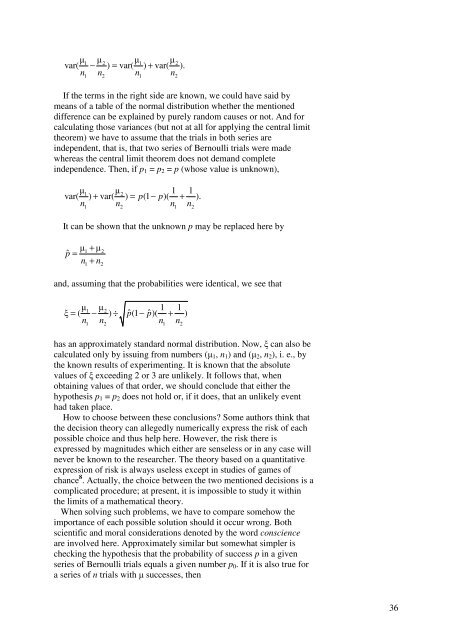1 Studies in the History of Statistics and Probability ... - Sheynin, Oscar
1 Studies in the History of Statistics and Probability ... - Sheynin, Oscar
1 Studies in the History of Statistics and Probability ... - Sheynin, Oscar
Create successful ePaper yourself
Turn your PDF publications into a flip-book with our unique Google optimized e-Paper software.
µ µ µ µn n n n1 2 1 2var( − ) = var( ) + var( ).1 2 1 2If <strong>the</strong> terms <strong>in</strong> <strong>the</strong> right side are known, we could have said bymeans <strong>of</strong> a table <strong>of</strong> <strong>the</strong> normal distribution whe<strong>the</strong>r <strong>the</strong> mentioneddifference can be expla<strong>in</strong>ed by purely r<strong>and</strong>om causes or not. And forcalculat<strong>in</strong>g those variances (but not at all for apply<strong>in</strong>g <strong>the</strong> central limit<strong>the</strong>orem) we have to assume that <strong>the</strong> trials <strong>in</strong> both series are<strong>in</strong>dependent, that is, that two series <strong>of</strong> Bernoulli trials were madewhereas <strong>the</strong> central limit <strong>the</strong>orem does not dem<strong>and</strong> complete<strong>in</strong>dependence. Then, if p 1 = p 2 = p (whose value is unknown),µ µ 1 1n n n n1 2var( ) + var( ) = p(1 − p)( + ).1 2 1 2It can be shown that <strong>the</strong> unknown p may be replaced here byµ + µˆp =n + n1 21 2<strong>and</strong>, assum<strong>in</strong>g that <strong>the</strong> probabilities were identical, we see thatµ µ 1 1ˆ ˆn n n n1 2ξ = ( − ) ÷ p(1 − p)( + )1 2 1 2has an approximately st<strong>and</strong>ard normal distribution. Now, ξ can also becalculated only by issu<strong>in</strong>g from numbers (µ 1 , n 1 ) <strong>and</strong> (µ 2 , n 2 ), i. e., by<strong>the</strong> known results <strong>of</strong> experiment<strong>in</strong>g. It is known that <strong>the</strong> absolutevalues <strong>of</strong> ξ exceed<strong>in</strong>g 2 or 3 are unlikely. It follows that, whenobta<strong>in</strong><strong>in</strong>g values <strong>of</strong> that order, we should conclude that ei<strong>the</strong>r <strong>the</strong>hypo<strong>the</strong>sis p 1 = p 2 does not hold or, if it does, that an unlikely eventhad taken place.How to choose between <strong>the</strong>se conclusions? Some authors th<strong>in</strong>k that<strong>the</strong> decision <strong>the</strong>ory can allegedly numerically express <strong>the</strong> risk <strong>of</strong> eachpossible choice <strong>and</strong> thus help here. However, <strong>the</strong> risk <strong>the</strong>re isexpressed by magnitudes which ei<strong>the</strong>r are senseless or <strong>in</strong> any case willnever be known to <strong>the</strong> researcher. The <strong>the</strong>ory based on a quantitativeexpression <strong>of</strong> risk is always useless except <strong>in</strong> studies <strong>of</strong> games <strong>of</strong>chance 8 . Actually, <strong>the</strong> choice between <strong>the</strong> two mentioned decisions is acomplicated procedure; at present, it is impossible to study it with<strong>in</strong><strong>the</strong> limits <strong>of</strong> a ma<strong>the</strong>matical <strong>the</strong>ory.When solv<strong>in</strong>g such problems, we have to compare somehow <strong>the</strong>importance <strong>of</strong> each possible solution should it occur wrong. Bothscientific <strong>and</strong> moral considerations denoted by <strong>the</strong> word conscienceare <strong>in</strong>volved here. Approximately similar but somewhat simpler ischeck<strong>in</strong>g <strong>the</strong> hypo<strong>the</strong>sis that <strong>the</strong> probability <strong>of</strong> success p <strong>in</strong> a givenseries <strong>of</strong> Bernoulli trials equals a given number p 0 . If it is also true fora series <strong>of</strong> n trials with µ successes, <strong>the</strong>n36









